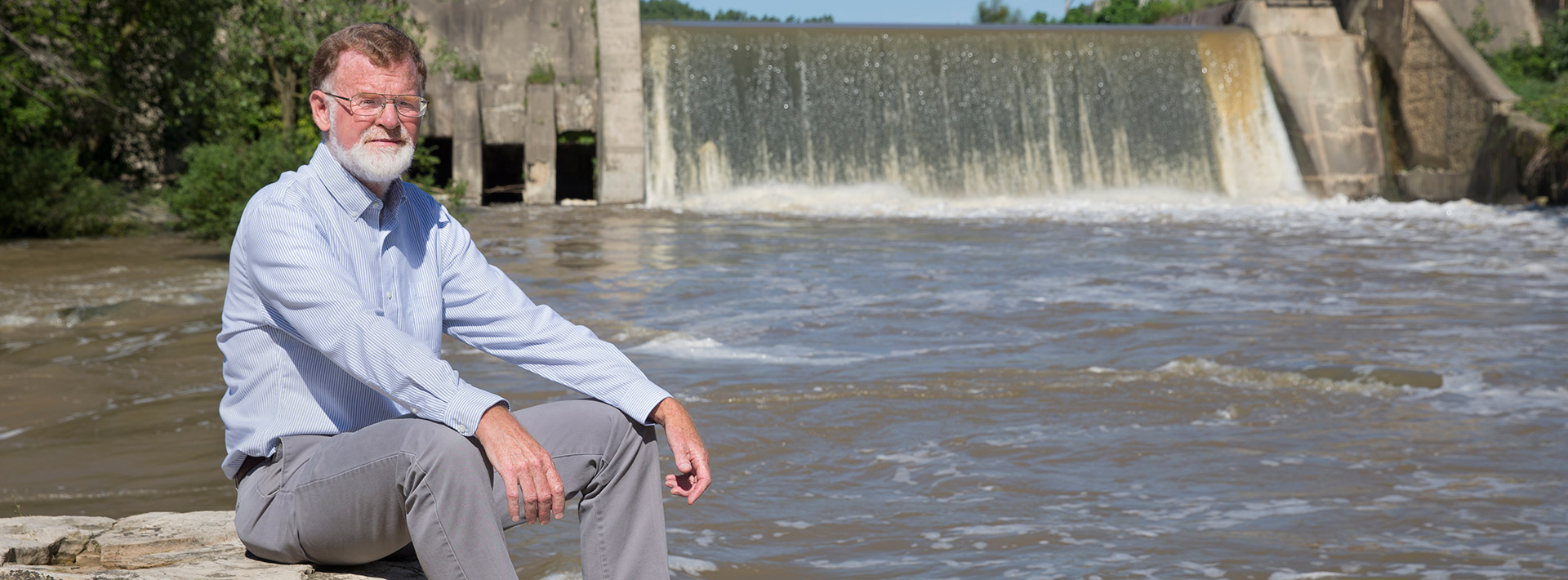Decision point
Evans advises on fate of aging dams

As America’s aging dams come under scrutiny, Dr. James Evans, geology, finds himself increasingly called upon to lend his expertise to questions about their possible removal or rehabilitation.
Evans, a national authority in hydrology, engineering geology and geological hazards related to dams, has been much in the news recently related to the controversy surrounding the Ballville Dam on the Sandusky River in Fremont.
Although the dam has been found structurally unsafe and the Army Corps of Engineers, the Ohio Environmental Protection Agency and the state’s Department of Natural Resources Fish and Wildlife Division have all approved its removal, a surprising development occurred that put that action into question.
“For the first time in the history of the country, an environmental group has tried to stop the removal of a dam,” Evans said.
“The Sierra Club is concerned that the release of nutrients trapped in the sediment behind the dam would cause toxic algae blooms downstream in Lake Erie, and they’ve filed a lawsuit to stop the removal of the dam. They propose first dredging and removing the built-up sediment before the dam is taken down. This would add appreciably to the cost of the dam removal and might even prevent it from taking place.”
Adjoining land owners who fear their lakefront property would be devalued if the dam were removed, and people who prefer lake boating and fishing to river recreation are also opposed.
Both sides, pro and con, have quoted research conducted by Evans and his students along with other BGSU faculty working collaboratively with University of Toledo faculty and scientists with the Ohio Geological Survey and Ohio EPA.
In the Ballville case, Evans recommended the dam’s removal, finding that contaminant levels in the sediments are less than existing already in Lake Erie sediments, and that contaminants released by the dam removal would be diluted before reaching the lake.
Evans noted that scientists recognize that dams offer both benefits and risks to the public; thus, he does not advocate that all dams be removed. “Each dam has to be looked at individually,” he said.
The background scientific studies typically take considerable time, but in some cases, the need for intervention is urgent. For example, the U.S. Army Corps of Engineers has found that the Buckeye Lake Dam near Columbus, Ohio, is in imminent danger of collapse, Evans said, an event that would have devastating consequences. If a catastrophic failure of the dam occurred, the resulting wall of water would be about eight feet high, threatening 3,000 homes and submerging a large stretch of I-70. In response, the state has appropriated $10 million for the dam’s repair, but fixing one dam ignores the magnitude of the problem, Evans said.
The Buckeye Dam is one of 77,000 larger dams in the U.S. (there are about 2 million smaller dams), each of which requires regular maintenance. In addition, Evans noted, any dam typically has a projected 70-year lifespan after which it needs to be demolished and removed. The majority of dams in country have outlived the purposes for which they were built, Evans said. Deferred maintenance has left them in poor repair, and a survey by the American Society for Civil Engineers has given them an overall grade of D. Over the past two decades, about 1,000 dams have been removed.
“Historically, dams were built for hydro power (mill dams), and more recently for hydroelectric power, flood control, navigation (locks and dams) and water supply,” Evans said. “The stated reason for dams’ removal is typically to improve water quality, ecosystem integrity or whitewater recreation, but ultimately it’s financial or liability issues that determine what happens to them.”
The history of Ohio is intimately tied to the history of dams, he said. During the 1830s-50s, many towns in Ohio were built for hydropower to drive mills, including Akron and most towns and cities in northeastern Ohio. In other parts of the state, dams were built to supply water to the canals that were so important to transportation before the advent of the railroads.
Evans was interviewed by Jennifer Smith Richards of The Columbus Dispatch about the safety concerns regarding the Buckeye Lake Dam and other dams in the state. He was quoted in her article “Lax Enforcement of Aging, Unsafe Dams Puts Ohioans at Risk,” published May 31.
He was also interviewed by Christopher McGreal from The Guardian, in the U.K., about dam safety in the context of aging infrastructure in the United States, with specific questions about Buckeye Lake Dam as an example of such a controversy.
Last year, Evans was appointed to a prestigious national working group called the “U.S. Geological Survey, John Wesley Powell Center for Analysis and Synthesis, Working Group on Dam Removal and Synthesis of Ecological and Physical Responses.”
“This group consists of 20 scientists from throughout the U.S. coming from both federal agencies and academia,” he explained. “The goal is to set national policy for the criteria that is to be used to make decisions about whether to remove a dam, based upon the anticipated benefits or detriments to the specific river and its ecosystems (for example, removing a barrier to the upstream migration of salmon). Using historical data, we study whether we can predict what’s going to happen if a dam is removed.”
Evans has been involved in the study of dams since 1994, when the IVEX dam near Chagrin Falls, Ohio, failed after a heavy rainfall, releasing about 10 million gallons of water (about 20 Olympic-sized swimming pools) in under two minutes. Since then, he has involved his students in his research, and it has been the topic of graduate research and several theses over the years. He has also served as an expert witness in a Wisconsin Superfund case in which $1 billion in damages have been assessed (the suite of related cases is still under adjudication).
Updated: 12/02/2017 12:47AM
